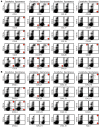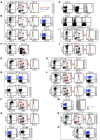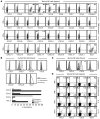Comprehensive assessment of chemokine expression profiles by flow cytometry
- PMID: 20197626
- PMCID: PMC2827956
- DOI: 10.1172/JCI40645
Comprehensive assessment of chemokine expression profiles by flow cytometry
Abstract
The chemokines are a large family of mainly secreted molecules involved in the regulation of numerous physiological and pathophysiological processes. Despite many years of investigation, the precise cellular sources of most chemokines have remained incompletely defined as a consequence of the limited availability of suitable reagents to visualize the expression of chemokine proteins at the single-cell level. Here, we developed a simple flow cytometry-based assay using commercially available chemokine-specific antibodies for efficient cell-associated detection of 37 of 39 murine chemokines. To demonstrate the utility of this methodology, we used it to reevaluate the nature of homeostatic chemokines in the hematopoietic compartment, to delineate the complete chemokine profiles of NK cells and B cells in response to major polyclonal stimuli, and to assess the chemokine response of DCs to bacterial infection. The versatility of this analytical methodology was further demonstrated by its application to selected human chemokines and should greatly facilitate any future investigation into chemokine biology at large.
Figures






Similar articles
-
Natural killer cells produce T cell-recruiting chemokines in response to antibody-coated tumor cells.Cancer Res. 2006 Jan 1;66(1):517-26. doi: 10.1158/0008-5472.CAN-05-2429. Cancer Res. 2006. PMID: 16397268
-
Differential chemokine responses and homing patterns of murine TCR alpha beta NKT cell subsets.J Immunol. 2003 Sep 15;171(6):2960-9. doi: 10.4049/jimmunol.171.6.2960. J Immunol. 2003. PMID: 12960320
-
Coordinate expression of cytokines and chemokines by NK cells during murine cytomegalovirus infection.J Immunol. 2004 Mar 1;172(5):3119-31. doi: 10.4049/jimmunol.172.5.3119. J Immunol. 2004. PMID: 14978118
-
Role of chemokines in the biology of natural killer cells.Curr Top Microbiol Immunol. 2010;341:37-58. doi: 10.1007/82_2010_20. Curr Top Microbiol Immunol. 2010. PMID: 20369317 Review.
-
[NK cells, chemokines and chemokine receptors].Klin Onkol. 2010;23(1):5-9. Klin Onkol. 2010. PMID: 20192067 Review. Czech.
Cited by
-
The Gp1ba-Cre transgenic mouse: a new model to delineate platelet and leukocyte functions.Blood. 2019 Jan 24;133(4):331-343. doi: 10.1182/blood-2018-09-877787. Epub 2018 Nov 14. Blood. 2019. PMID: 30429161 Free PMC article.
-
A role for the chemokine RANTES in regulating CD8 T cell responses during chronic viral infection.PLoS Pathog. 2011 Jul;7(7):e1002098. doi: 10.1371/journal.ppat.1002098. Epub 2011 Jul 21. PLoS Pathog. 2011. PMID: 21814510 Free PMC article.
-
Expression and regulation of chemokines in murine and human type 1 diabetes.Diabetes. 2012 Feb;61(2):436-46. doi: 10.2337/db11-0853. Epub 2011 Dec 30. Diabetes. 2012. PMID: 22210319 Free PMC article.
-
Aging of Antiviral CD8+ Memory T Cells Fosters Increased Survival, Metabolic Adaptations, and Lymphoid Tissue Homing.J Immunol. 2019 Jan 15;202(2):460-475. doi: 10.4049/jimmunol.1801277. Epub 2018 Dec 14. J Immunol. 2019. PMID: 30552164 Free PMC article.
-
Early and late changes in natural killer cells in response to ledipasvir/sofosbuvir treatment.Hepatol Commun. 2018 Mar 1;2(4):364-375. doi: 10.1002/hep4.1166. eCollection 2018 Apr. Hepatol Commun. 2018. PMID: 29619416 Free PMC article.
References
Publication types
MeSH terms
Substances
Grants and funding
LinkOut - more resources
Full Text Sources
Other Literature Sources

